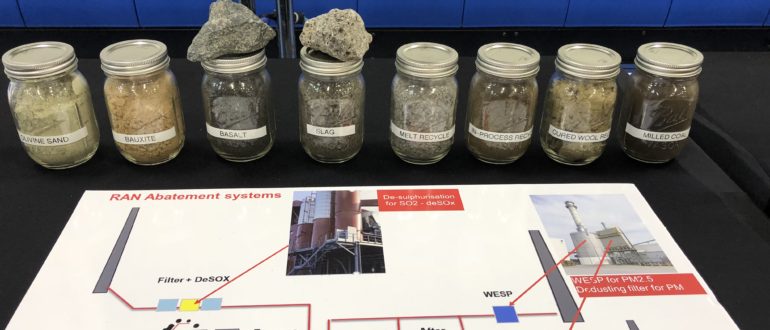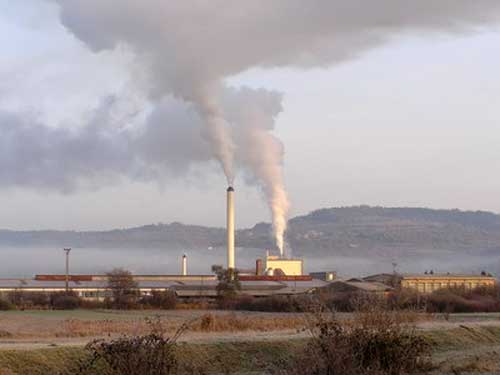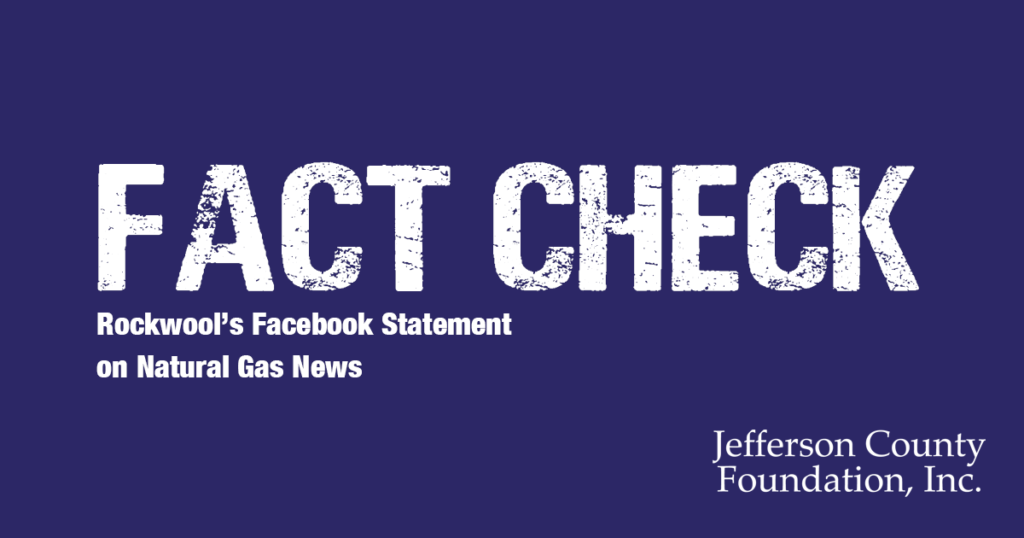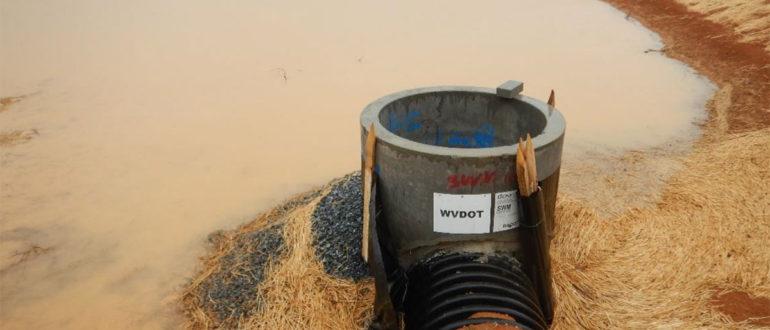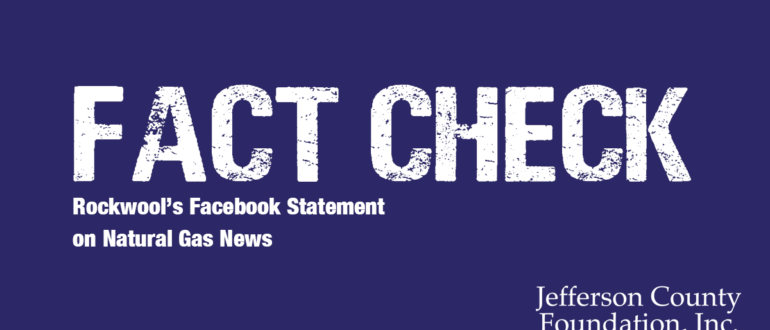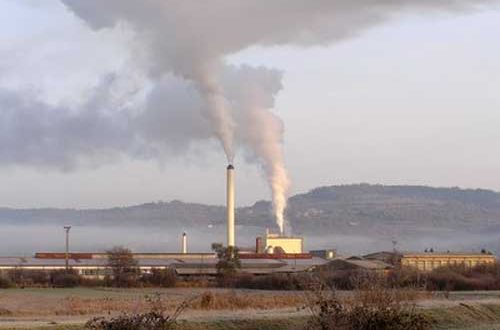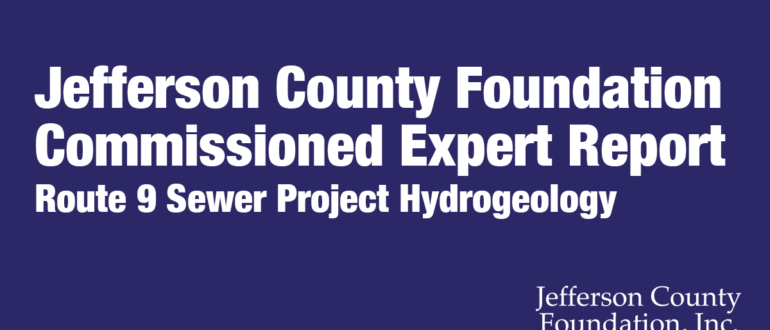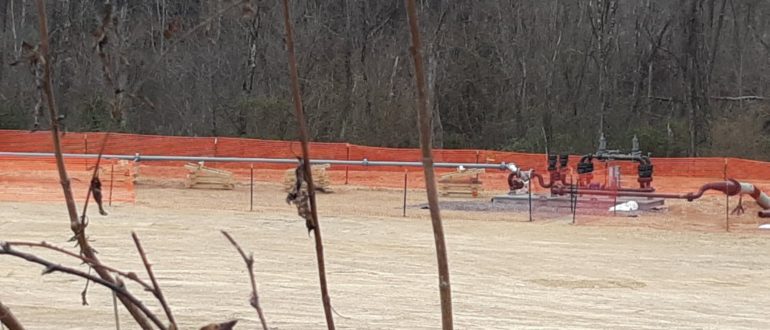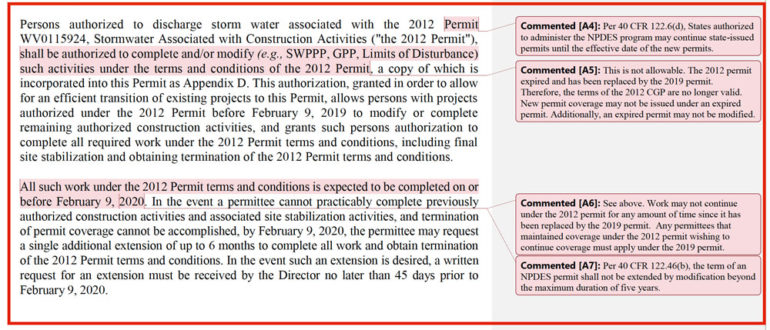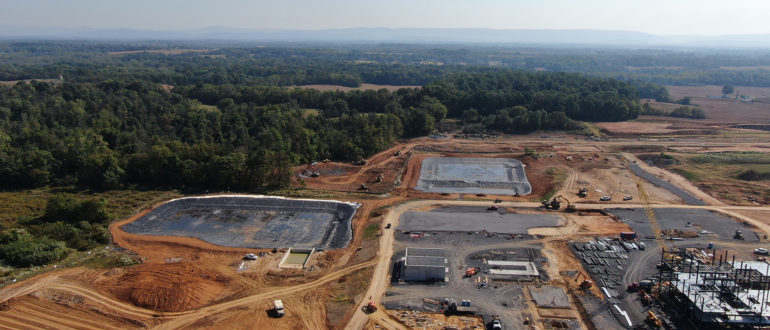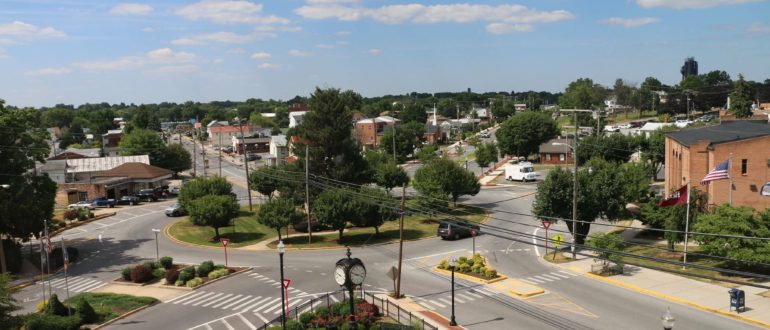Jefferson County Foundation has put together a tutorial to further help clear up confusion about Rockwool’s recent announcement about changing their fuel source. Does that mean they are no longer using coal at all? Watch the video to find out (see below, or watch it here on our Youtube Channel).
Ranson and the DEP Violate the Clean Water Act at Road to Rockwool
Jefferson County Foundation sends Notice of Intent to File Suit
Ranson is administering the Northport Avenue road extension construction project — the road to Rockwool — for the West Virginia Department of Highways without a valid construction stormwater permit. The project has been inspected by the West Virginia Department of Environmental Protection (DEP) three times and each time, Ranson has had violations. Jefferson County Foundation filed a Notice of Intent to file suit on Friday, August 7. “Our hope is that Ranson will apply for a valid Construction Stormwater General Permit Registration (CGPR) under the 2019 General Permit,” states Foundation president, Christine Wimer. “We want the DEP to require Ranson and all such entities to obtain a valid construction stormwater general permit registration. And we want the EPA to require the DEP to abide by the EPA’s objection to the DEP allowing entities to continue to operate under the invalid and less protective 2012 permit.”
Background:
The Northport Avenue extension is a project administered by the City of Ranson for the West Virginia Department of Highways (WVDOH) to extend the road and utilities in front of Rockwool. It comprises approximately 0.65 miles (or approximately 3200 LF) of a multimodal Urban Local Road and utilities that will extend the existing Northport Avenue from West Virginia Route 9 to the northern boundary of the former Jefferson Orchards parcel with a reported limit of disturbance of 24.4 acres.
Ranson accepted bids for this project from February 13, 2019 to March 11, 2019. The project was awarded to Jefferson Asphalt on April 2, 2019 by a vote of the city council (Resolution #2019-13 – A Resolution of the City Council of Ranson, West Virginia Approving a Contract with Jefferson Asphalt for the Construction of Northport Avenue).
Permitting:
A Construction Stormwater General Permit Registration (CGPR) has been applied for three times for this project by the City of Ranson.
The CGPR application was first applied for, for this project on July 23, 2018 under the 2012 Construction Stormwater General Permit (CGP). This application was terminated on December 14, 2018, by the DEP for lack of response by Ranson to DEP requests.[1] Ranson started a second Construction Stormwater General Permit Registration application on January 9, 2019. The permit was issued less than a month later on February 6, 2019. In this application, it was stated that construction would start on February 1, 2019 and end by December 31, 2019. As this was less than one year, no public comment or public notice was provided for.
The last (chronologically) comment from the permit reviewer on February 5, 2019 stated:
“The re-issued permit, WV0115924, effective February 9, 2019 requires that all BMP’s listed in the application are required to be ENHANCED BMP’s. This permit can [be] found on our website:”
“All permits issued between Feb. 9, 2018 & Feb. 9, 2019 will be given an opportunity to submit a form stating that they will be following the new permit.
This permit application has shown that “silt fence” will be used rather than the Enhanced BMP “Super Silt Fence” or “Belted Silt Fence”. Please replace these in your application and make this correction on all of your maps and narrative showing that the Re-issued Permit will be followed.”
Clearly it was the intention of the DEP to approve the permit by February 9, 2019 to afford the city of Ranson the opportunity to qualify for this provision, and allow Ranson to avoid applying under the 2019 permit. This comment was at least partially addressed by the city. In the SWPPP, 4 of the 11 times that silt fence is referred to, it was updated to belted silt fencing. However, the much larger issue here is that the permit reviewer incorrectly implies that the only difference between the 2012 and 2019 is the Enhanced BMP. This is an egregious oversimplification. Most notably, this project would have to have a stand-alone project specific GPP (Groundwater Protection Plan) with a Karst Mitigation Plan. This was not done.
Nevertheless, after issuance of the permit registration on February 6, 2019, this project was not started in February as initially planned.
On June 7, 2019, a reissuance of the registration under the 2019 permit was applied for and granted on September 11, 2019. This application was incomplete with only 7 out of 20 sections submitted and provided for; no substantive changes to the actual stormwater handling. The only two changes were to the signature page, now referred to the 2019 general permit, and the timeline was lengthened to over one year. No actual review of this application seems to have been done with no comment or applicant comments recorded, and no record of review in the application tracking page.
The City of Ranson is now operating this project under this reissuance and has incurred multiple violations.
Northport Avenue: A Timeline
Issues:
The DEP seems to have rushed Ranson’s registration application for this project such that Ranson would avoid having to reapply under the 2019 permit. The DEP did so by approving the permit registration just two days before the deadline and less than 30 days after the application was first initiated. Only a cursory attempt was made 24 hours before the application was approved to bring it up to the standards of the 2019 general permit. Only a few words were changed and no substantive changes were made. Most notably, a Karst mitigation plan was not required. Several months later, prior to the start of construction, the permit was reissued under the 2019 general permit with no change to the substance of the application. The only change was to the timeline, which was lengthened from 11 months to more than 13. No public notice or comments were performed, as required by the permit conditions of the 2019 (and 2012) permit. Here in this case yet again we have no public notice and an end run around the 2019 permit conditions.
Though Ranson has a registration under the 2019 CGP, they do not have the required elements of that registration including a site-specific groundwater protection plan and a karst mitigation plan. Without these critical components Ranson is unable to meet the requirements of the 2019 and is effectively operating under the 2012 permit conditions. Therefore Ranson’s registration is invalid, and they are operating a construction project in violation of the Clean Water Act. Jefferson County Foundation hopes this letter persuades Ranson to apply for a valid registration under the 2019 permit, the DEP to require Ranson to do so, and the EPA to force the DEP to stop allowing entities to operate under the 2012 permit conditions.
Site inspection and violations:
The site has been inspected three times (February 6, March 11, and May 14) and incurred two notices of violations (February 6 and May 14). They repeatedly have the same violations and have even been found to have sediment-laden water leaving the construction site. Despite the warnings and violations Jefferson Asphalt seems unable to correct the errors. For example, they have been cited all three times for not having an outflow marker (permit cite evaluation number 4). Not only are they operating without a valid CGPR, but they are incurring multiple violations endangering the water resources of the county and region.
[1] Quoted directly from the Application Milestones page of the application RANSON, CITY OF New NPDES/State Storm Water Construction #1 WVR110004
Fact Checking Rockwool’s Statement on Natural Gas News
Rockwool recently posted on their Rockwool Ranson Community Facebook page that they are “planning to start operations using natural gas instead of coal.” It’s interesting that they are only now talking about this since they notified the West Virginia Department of Environmental Protection in March of 2020. It has been 143 days. Why the long wait? Maybe it’s because Jefferson County Foundation wrote the DEP and the EPA on Wednesday, July 29 telling them that Rockwool needs to redo their air permit because of their change in operating parameters. Rockwool wants to have a shiny object to distract us from there are major issues here that need to be addressed.
Issues
- Rockwool and the DEP need to entirely re-do the BACT analysis with natural gas as the sole fuel source for the Melting Furnace.
- At minimum a Class II administrative change with public notice needs to be made for this modification or more appropriately an entirely new air permit.
- The DEP and Rockwool need to be transparent about this process including providing all the redacted information from the permit application to the public so the public may adequately evaluate the emission limits and BACT.
What Rockwool Said and What are the Concerns
In their statement from July 31, 2020, Rockwool states:
“That’s right – we’re planning to start up factory operations using natural gas instead of coal.
Converting from coal to natural gas for the melting furnace will significantly reduce the environmental impact of our operations – that’s great for Jefferson County and beyond.”
It is critical to note that Rockwool was planning to use coal not only to fuel the Melting Furnace, but as a raw material, also known as an in-process fuel. The Melting Furnace was meant to be powered by four oxy-fuel burners (natural gas) creating 23% of the energy and five coal burners (burning crushed powered coal) creating 77% of the energy (as measured by MW).1 But they were also using coal as raw material in the actual melting furnace.2 It seems they now plan that they intend to replace these five coal burners with oxy-fuel burners. Are they saying, they plan to use no coal in any process as raw material or fuel of any type – 100% no coal?
There is no way to know for sure, either from their letter or this statement.
The press needs to push: Is Rockwool 100% stopping the use of coal completely in all processes and all capacities? Or, will Rockwool continue to use coal in some capacity, just not to fuel those five burners for the Melting Furnace?
Rockwool states:
“We expect CO2 emissions from the melting furnace to decline by around 30 percent along with reductions in other emissions as well.”
What they don’t say is that the Carbon Monoxide (CO), a regulated emission in its own right, will increase significantly.3 And, what is more important is do they plan to appropriately abate with the Best Available Control Technology, which will actually produce more CO2?
The answer to this is unknown, because the DEP inappropriately accepted this as a Class I administrative change, instead of the Class II administrative change with public notice, this increase in regulated emission legally qualifies for. Rockwool needs to be required to redo the Best Available Control Technology (BACT) for the Melting Furnace. They need to choose BACT that is appropriate for this new emissions profile and have the EPA review it. Therefore, it would be best if they applied for an entirely new permit.
“Converting to natural gas also means less heavy truck traffic, as we will not need any coal deliveries – another win for Jefferson County and the environment.”
We agree! Thank you!
“And in case you’re wondering, Mountaineer Gas will supply the gas via the existing pipeline infrastructure, which is already completed and well-functioning. This conversion will not require natural gas truck deliveries to the factory.”
Wow, really interesting that they waited until the day after the FERC public comment was closed to say this!
Columbia Gas has recently applied for an extension of their Certificate of Public Convenience and Necessity (CPCN) for the Potomac Pipeline. This is a pipeline that will carry fracked gas from Pennsylvania to the Mountaineer Gas line in the Eastern Panhandle gas line extension, which will carry gas to Rockwool. The project was originally permitted in 2018 but was not constructed due to a legal battle with the state of Maryland. This pipeline will cross 19 streams, 10 wetlands, and the Potomac River, which supplies water to over 6 million people downstream of that point. Columbia Gas has always argued that the gas is needed in Jefferson County, i.e. by Rockwool. The Federal Energy Regulatory Committee (FERC) was accepting public comment until July 30 on the extension of the CPCN for the pipeline. If Rockwool had announced this information before the deadline, many of us would have used this information to argue that the gas line does not fulfill a public necessity.
Temporal coincidence?
“That we’re able to convert to natural gas is a result of the highly advanced, proprietary, fuel-flexible melting technology that we’re deploying here. To our knowledge, no one else in our industry has this capability.”
Rockwool is a very old product that has been replaced by products that do not require such environmentally unfriendly practices to make. Many will remember there was once a Rockwool plan there in Jefferson County but it went out of business before most of us were born. So, saying you are doing better than a dying breed is not saying much.
Also, if this is first of its kind technology, then the air permit is completely wrong! The air permit was based on the emissions “proportionally scaled down” from the Byhalia, Mississippi plant. Now we are to understand that the Byhalia plant does not even have the same type of furnace? This means the air permit must be completely redone.
“The air permit authorizing our operations allows for using both fuel sources – and it has always been part of the plan to eventually convert to natural gas for the melting process. We’re extremely pleased that we’re able to start up on gas, thus reaping the environmental benefits of doing so straight away.”
Actually, in the air permit application, Rockwool said that using only natural gas in the Melting Furnace was “technologically infeasible.” According to the Rockwool permit application: the use of only natural gas as a fuel would “fundamentally redefine the process of a coal/natural gas/oxy-fired Melting Furnace.” And in Rockwool’s BACT analysis for CO2e (greenhouse gases) from the Melting Furnace, natural gas as a fuel source instead of coal was specifically excluded, because it was said to be “technically infeasible.”
This means the DEP and Rockwool independently need to redo the BACT analysis for the Melting Furnace considering natural gas as the only fuel sources for the Melting Furnace. Now that Rockwool has admitted they can afford to use natural gas as the sole fuel source in the Melting Furnace and that it is technically feasible to do so. Rockwool should therefore be required to use only natural gas as a fuel source as it is the best available technology for containment of CO2e, and should not be allowed to revert to coal if and when they so choose.
Further, Rockwool’s BACT analysis of NOx for the Melting Furnace, because coal instead of natural gas was being utilized, Low-NOx and Ultra Low-NOx natural gas burners were not considered as a technically feasible option for BACT of NOx for that emissions source. Rockwool needs to be required to use them now.
By having first applied for an air permit and claiming it was technically necessary to operate with coal-burning technology, then at a later date substituting that with natural gas-only technology, Rockwool has avoided appropriate BACT analysis. In doing so, Rockwool achieved being permitted for far more emissions than are necessary for their process, and afforded themselves built-in leniency for their emissions. This kind of deception and disregard for our air quality cannot be tolerated. And certainly, should not be celebrated as some sort of altruistic sacrifice!
Click here to see a video tutorial on Rockwool’s Change in Operating Parameters
1 Rockwool application to Office of the State Fire Marshall for Varience, 4/10/18
2 Information presented at Rockwool Open House in 2018
3 Based on AP-42 – EPA Compelation of Air Emmision Factors and Process Information Standard Reference
Rockwool Changing Fuel Source – Needs New Air Permit
Jefferson County Foundation is calling on the West Virginia Department of Environmental Protection Division of Air Quality (WVDEP) and the federal Environmental Protection Agency (EPA) to have Rockwool redo its air permit due to a change in fuel source. It has come to light that Rockwool notified the WVDEP in March of 2020 that it plans to operate its Melting Furnace using only natural gas.
Background
In a March 2, 2020 letter (click to view) to the West Virginia Department of Environmental Protection (DEP), Rockwool made the DEP Department of Air Quality (DAQ) aware that they were changing their fuel source for the Melting Furnace and will now use natural gas as the sole fuel source.
We are encouraged that Rockwool maybe using less coal in their process. However, there are some really important things to note with this change and there are major issues that must be addressed to ensure the air of our region is protected as much as it could be.
Though Rockwool will stop using coal as fuel in the Melting Furnace, they will still be using coal as a raw material or an in-process fuel. Why don’t we know for sure how much coal? Because the DEP DAQ did not follow up and require that Rockwool define this change further. The DEP reply letter states:
“The Division of Air Quality confirms that on March 4, 2020, we received your letter that provided information on Roxul’s plans to operate the Melt Furnace using only natural gas and without the use of coal. Please note that all applicable conditions in the permit remain in effect.
Should you have any questions, please Mr. Joe Kessler at (304) 414-1271.”
Key Points
That’s it. That’s the letter. You can view the letter from the WVDEP here.
These two letters were posted in a location on the DEP website with a small, seemingly random collection of communications, including only four postings since the final approval of the construction air permit in April of 2018. The DEP didn’t publish these letters on the website until sometime after May 20, 2020.
The issues
While we are encouraged that Rockwool maybe using less coal, this situation creates or highlights three issues that must be addressed by the DEP DAQ urgently.
- Rockwool and the DEP need to entirely re-do the BACT analysis with natural gas as the sole fuel source for the Melting Furnace.
- At minimum a Class II administrative change with public notice needs to be made for this modification.
- The DEP and Rockwool need to be transparent about this process including providing all the redacted information from the permit application to the public so the public may adequately evaluate the emission limits and BACT.
These issues need to be immediately addressed by the DEP DAQ.
1. BACT Analysis Needs To Be Redone
What is BACT?
BACT stands for Best Available Control Technology. It is required on major new or modified stationary sources of air pollution in clean areas (i.e., attainment areas). Jefferson County is an attainment area. Rockwool is a major stationary source of air pollution. They had to conduct a BACT Analysis and present it with their Prevention of Significant Deterioration (PSD) Air Permit Application to DEP. DEP was supposed to do their own version and then compare it with what the company said they though the BACT should be. DEP did not do their part; instead, they took Rockwool’s word.
A BACT Analysis is called a “top-down” evaluation, meaning that one starts with the best controlling technology or mode of operation, including type of fuel. Top-down BACT consists of the following 5 step process:
- Step 1 – Identify all control technologies
- Step 2 – Eliminate technically infeasible options
- Step 3 – Rank remaining control technologies by control effectiveness
- Step 4 – Evaluate most effective controls and document results
- Step 5 – Select BACT
General Requirements
A. Best Available Control Technology (BACT) means an emission limitation (including opacity limits) based on the maximum degree of reduction which is achievable for each pollutant, taking into account energy, environmental, and economic impacts, and other costs.
B. The analysis must be pollutant and emission unit specific with respect to each pollutant subject to a BACT review.
C. Evaluate entire range of demonstrated options, including alternatives that may be transferable or innovative.
D. The level of detail in the control options analysis should vary with the relative magnitude of the emissions reduction achievable.
E. Emission limits should be expressed in pounds/hour (based on maximum capacity) and in terms of process unit variables such as material processed, fuel consumed or pollutant concentrations (e.g., lbs/MMBtu, lbs/gal of solids, g/dscm).
F. Emission limits and work practice standards must be enforceable. Permit conditions should specify appropriate stack testing, continuous emission monitoring, continuous process monitors, recordkeeping, etc.
Impact Analysis
Here are some examples of where energy, economic, or additional environmental impact can be factored in, resulting in a high-ranking, technologically feasible BACT to be excluded.
- Energy
Natural gas for operating an afterburner is not available based on local regulations. - Economic
- The increased cost of the final product (e.g., automobile, cement, coke, etc.) would increase to a level so that the entire project would no longer be feasible.
- The increased cost is way out of proportion to the environmental benefit. (e.g., the increased cost of going from 93% to 94% control increases the capital cost from $2,000,000 to $4,000,000 and the operating costs from $500,000/year to $1,000,000/year but reduces the emissions of nitrogen oxides by only 50 tons per year.)
- Environmental
A wet scrubber may create a by-product which cannot be disposed of without creating a more detrimental impact.
In the original BACT analysis for the Melting Furnace, Rockwool claimed that using natural gas as a sole fuel source was “technically infeasible.” Specifically, because Rockwool claimed this, they were allowed to used coal, despite the fact that this has higher emissions of CO2e, and SO2. Now that Rockwool is admitting that using natural gas as the sole fuel source for the Melting Furnace is technically feasible and affordable, they must be REQUIRED to do this as it is the best available technology to reduce emissions.
Because Rockwool was not considering using natural gas as the fuel source for the Melting Furnace, they did not consider the best available technology for controlling emissions from the natural gas burners. This must now be done to further limit emissions. For example, the best available technology to limit NOx from natural gas burners is the use of Low or Ultra Low-NOx burners. This was not considered by Rockwool or required of them because, again, this was not considered a technically feasible fuel source.
Natural gas burners actually produce more carbon monoxide than does coal combustion. Therefore, this must be evaluated to ensure the best available technology is being used to maximally control the emissions of carbon monoxide. In this case, oxygen is being used and may be required at a higher rate to account for the increased CO emission.
By having first applied for an air permit and claiming it was technically necessary to operate with coal-burning technology, then at a later date substituting that with natural gas-only technology, Rockwool has avoided appropriate BACT analysis. In doing so, Rockwool achieved being permitted for far more emissions than are necessary for their process, and afforded themselves built-in leniency for their emissions. This kind of deception and disregard for our air quality cannot be tolerated. Further, it is clear that one cannot rely on the Title V permit (operational air permit) process to provide a backstop protection for these insufficiencies, as Rockwool has been operating in Byhalia for over five years and has yet to obtain a Title V permit.
The BACT analysis must be redone in light of this new information, that natural gas is now technically feasible for use in the Melting Furnace, so that Rockwool is required to use the truly best available technology and incorporate more appropriate emission limits into the permit.
How much does the Melt Furnace contribute to the emission of the plant at Rockwool Ranson?
We know from the Fire Marshall that 77% of the power for the Melting Furnace was being provided by coal and 23% was being provided by natural gas. This is a change of 77% in the highest emission source for most emissions.
| Emission (pollutant) | % of total emissions from Melting Furnace | Tons Per Year From Melt Furnace | Total Tons Per Year Produced by the Plant |
|---|---|---|---|
| NOx | 67% | 163.37 | 274.31 |
| SOx | 100% | 147.31 | 147.31 |
| Acid gas (H2SO4) | 100% | 16.37 | 16.37 |
| Greenhouse Gas CO2e | 62% | 95,547 | 152,933 |
| PM10 | 23% | 36.01 | 155.59 |
This fuel change represents a 77% change in the emissions source that creates 70% of the plant’s overall emissions.
2. Rockwool needs a new air permit!
At very least, this needs to be considered a Class II administrative change with public notice. 45 C.S.R. 13-4(2)(b), requires that a “Change in a permit condition as necessary to allow changes in operating parameters, emission points, control equipment or any other aspect of a source which results in an increase in the emission of any existing regulated air pollutant or any new regulated air pollutant; or” requires a Class II modification. This description is met by this change and, therefore, a Class II administrative change with public notice should be conducted.
This will require a change in operating parameter, as the Melting Furnace will now be using only natural gas as a fuel. While Rockwool says that this was previously approved, in the publicly facing documents of the air permit there was no specific approval of natural gas for use in the Melting Furnace. If there in fact was approval of this, then several other required steps were omitted (as outlined in the letter).
As already discussed, the control equipment will need to be changed based on a new BACT analysis. This is critical to keep air emissions as low as possible.
This change in fuel source will result in an increase in emission of CO (carbon monoxide)[1]. CO is an existing regulated air pollutant.
Because this change in operating parameter will require a changing control equipment and result in an increase in emission of a regulated air pollutant, a Class II administrative change with public notice is required. This was not done and it must be corrected. Due to the BACT needing to be redone as noted previously, EPA review is required and, because a majority of the emissions come from this source (Melting Furnace), it would be most appropriate to require Rockwool to do an entirely new permit.
[1] According to AP-42 – EPA Compilation of Air Emission factors and process information standard reference for air permitting since 1972. https://www3.epa.gov/ttn/chief/ap42/ch01/
3. Transparency and Due Diligence
The original permit
The Clean Air Act and state regulation prohibit redaction of any information that meets a broad definition of “emissions data.” Rockwool and the DEP obfuscated this requirement by including much of this information by citation only. This information was cited in the PSD application where much of the information was redacted from public view. This information must be provided to the public so the public can property evaluate the BACT and emissions limits.
Notifying the Public of this change
It is not clear why this recent and important communication was posted in a seldom viewed location with seemingly random communications or how the public would have known that this is the location they should have been watching for such information.
Rockwool must provide more information about this change
The DEP’s response letter seems intentionally vague and invites further non-written communication. This overtly limits public awareness of the process and implications of such actions. The DEP handling of this thus far perpetuates the lack of transparency and lack of due diligence that has plagued the agency’s handling of the Rockwool project from the start.
What Needs to Happen
We ask that a Class II administrative change with public notice be conducted or Rockwool be required to seek an entirely new air permit, that the BACT analysis be repeated by both Rockwool and the DEP independently, that EPA be advised of these significant permit changes, and that the process be conducted in an open and transparent way including making all cited redacted material available to the public.
Hydrogeology Expert Confirms: Groundwater at Risk for Contamination in Route 9 Sewer Project
Jefferson County Foundation has received and submitted to the West Virginia Environmental Quality Board, a significant hydrogeology report, confirming that the waters of Jefferson County — and the Chesapeake Bay Region — are at risk from the construction of the Route 9 Sewer Project. In the report, which has been submitted to the Board in the Sewer Line litigation, the expert concludes:
“…the most concerning potential risk from both construction and operation of sewer line is for groundwater contamination. In the case of a pipeline failure (more common in karst areas than others because of the potential for loss of structural support) groundwater contamination could be catastrophic in ecological terms (the federally threatened Madison Cave isopod lives within the karst aquifer of Jefferson county) and creating human disruptions by polluting groundwater, springs, and the surface waters to which these springs flow.”
This report was prepared as part of Jefferson County Foundation’s appeal of the DEP Unilateral Order 9080 that allows Charles Town to operate the Route 9 Sewer Project without a valid NPDES stormwater permit in violation of the Clean Water Act. This assessment is important far beyond the litigation that the Foundation is participating in. We urge you to read it and share it with others that wonder what this fight is all about. You can view the report here.
[wpdm_package id=’2369′]The evaluation, reports, and testimony of this caliber expert can cost thousands of dollars. The Foundation is committed to pursuing what we need to achieve our goals but we need your financial help! If you are able, please make a fully tax deductible donate to Jefferson County Foundation and THE FOUNDATION LEGAL FUND. Help spread the word!
Columbia Gas Needs a New Certificate – FERC Needs to Hear From You
There’s an opportunity to help prevent a gas pipeline to Rockwool from being complete and the clock is ticking. Please consider sending in a comment asking the Federal Energy Regulatory Commission (FERC) to deny this permit. We’ve outlined talking points for you to submit comments either via the FERC eFiling site or via mail. Comments are due July 30.
What Happened
Columbia Gas Transmission, LLC, a subsidiary of TransCanada originally obtained a Certificate of Public Convenience and Necessity (CPCN) from the Federal Energy Regulatory Commission (FERC) on July 19, 2018 for an 8-inch, 3.37-mile fracked gas line from Fulton County, Pennsylvania into Morgan County, West Virginia. This line would connect an existing Columbia Gas line in burrow under the Potomac River and connect with the Mountaineer Eastern Panhandle Expansion Project pipeline in Morgan County, West Virginia. This line would eventually service the Rockwool plant in Ranson.
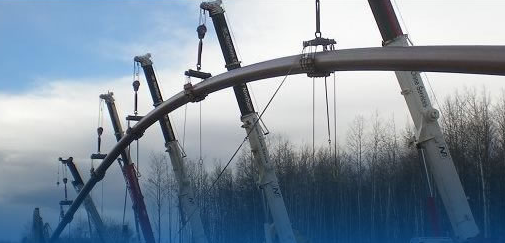
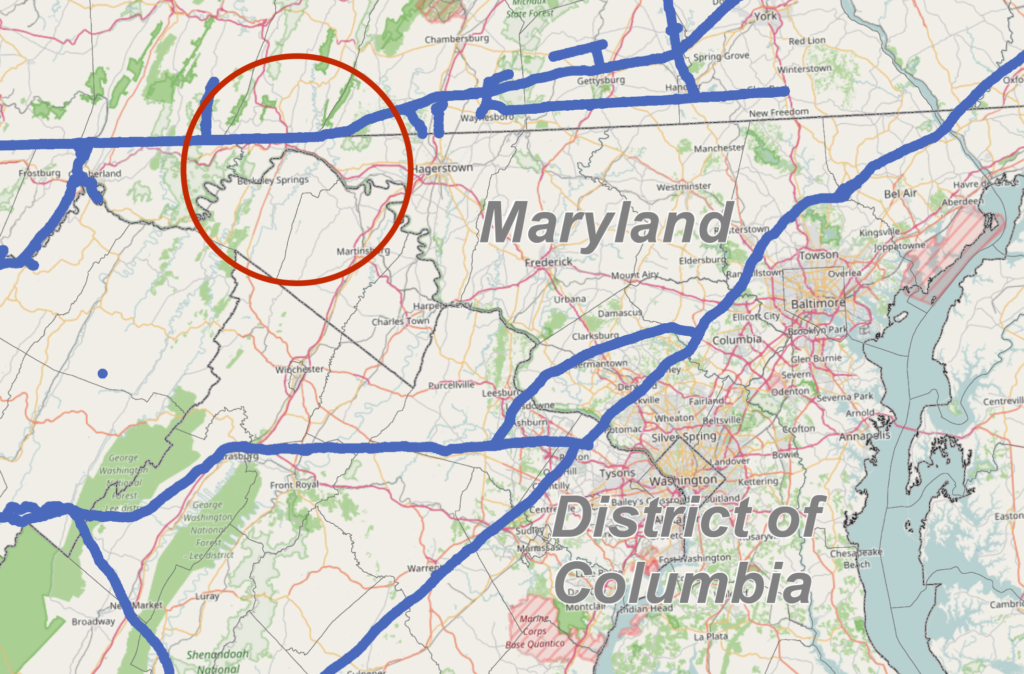
The pipeline would be installed under the Potomac River using Horizontal Directional Drilling (HDD). Compared to traditional trenching, HDD can reduce the amount of sediment generated during pipeline river crossings construction. However, the installations of the pipeline with HDD still has the potential to cause environmental damage through inadvertent releases of drilling fluids. Adverse environmental effects that can be expected from drilling fluid releases are likely to be similar to those resulting from sediment discharges. The current available literature focuses on toxicity of drilling muds and the individual components of the mud. Directional errors can also be made when drilling, and long-term studies of the pipe integrity are lacking.
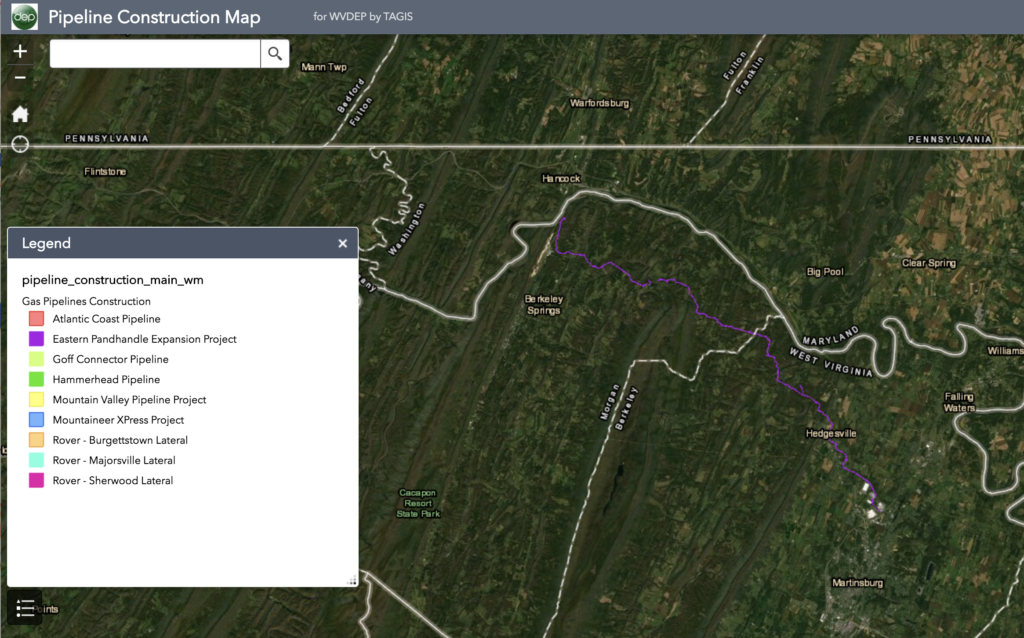
According to 65 Maryland delegates and senators, the pipeline will affect 10 wetlands and 19 streams in addition to crossing the Potomac River, which provides drinking water to more than 6 million people east of the crossing site. In January of 2019, Maryland Board of Public Works denied Columbia Gas a right-of-way permit under the Western Maryland Rail Trail. In August 2019, a federal court upheld the denial, and Columbia Gas is appealing. Thus, the project is currently on hold.
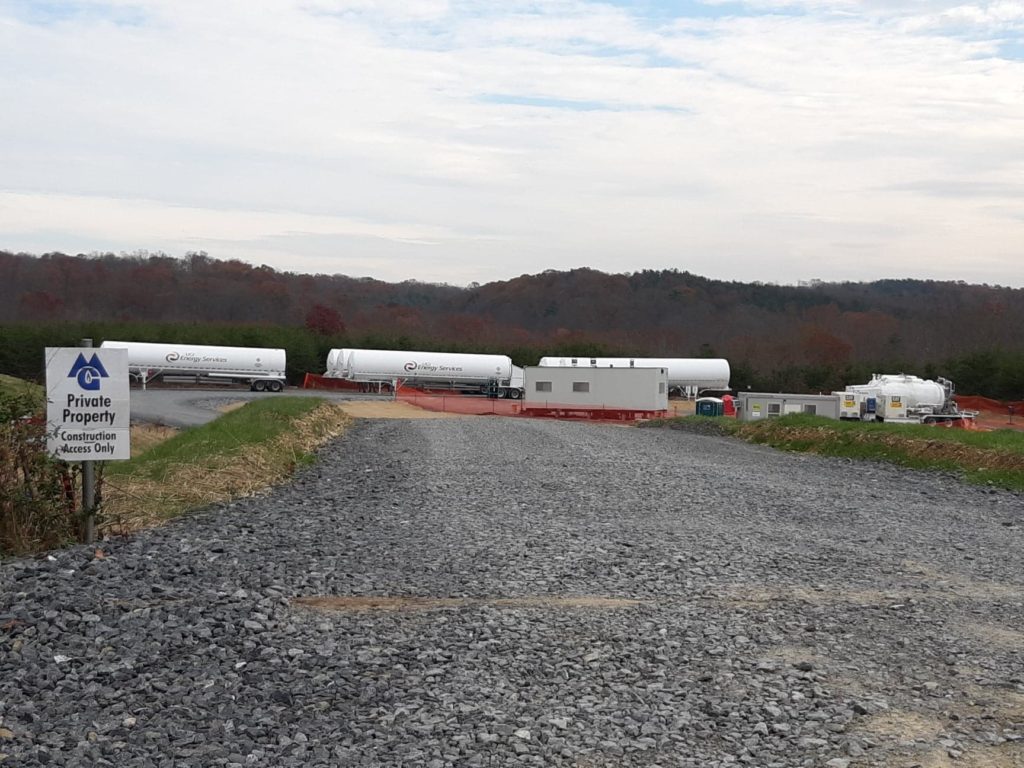
Since this project has been put on hold, Mountaineer Gas has found an alternative to provide Rockwool with the natural gas supply that it needs. From October 2019, Mountaineer Gas was building a receiving area for natural gas at the US Silica property on RT. 522. in Berkeley Springs.
We know that Mountaineer Gas is working on obtaining property in Berkeley County to build a Compressed Natural Gas facility to inject gas into the Route 9 Extension Project pipeline piece that was constructed in 2019 in order to deliver natural gas.
This project is simply not worth the risk, especially with the new information available in the last two years.
Legal Requirements for Extension of Permit
The Commission applies a two-part test in weighing extension Requests:
Part 1: Has the applicant demonstrated good cause for extending the deadline? 61,081, at ¶ 9 (2018).
Part 2: Is the project still required by public convenience and necessity and has there been “significant new circumstances or information relevant to environmental concerns”. Id ¶ 16-17.
These Requirements Are Not Met
- The applicant Columbia Gas does not demonstrate good cause for extending the deadline.
- The lawsuits that resulted in the delay were foreseeable and therefore Columbia has not shown good cause for an extension.
- These lawsuits may make it necessary to reroute the pipeline. Rerouting the pipeline would require a new application. Therefore, this certificate should not be extended. In fact, a new route that is more environmentally friendly should be proactively sought.
- The project is no longer required by public convenience and necessity.
- There is no need for the pipeline now that mountaineer Gas has found an alternative gas supply. Therefore, the need does not outweigh the risk.
- There is significant new information relevant to environmental concerns.
- New information about the risk and potential impacts on public health and safety posed by horizontal directional drilling under the Potomac River and C & O Canal since the original Certificate of Public Convenience and Necessity was issued. This Risk is not outweighed by the need.
- This type of drilling can cause contamination of waterways and damage to structures. Check out this recent article.
- The climate change impacts of burning the natural gas transported by this pipeline is now even more well understood, and this should be avoided in favor of more environmentally friendly methods.
- This pipeline will support the future expansion of fracked gas extraction in Pennsylvania the environmental impacts of fracked gas are now understood to be even more negative than before and should not be facilitated by more pipeline infrastructure.
- Natural gas as a commodity is under decreasing demand, therefore, it doesn’t make sense to build more infrastructure to support it.
What Can You Do?
Send FERC a comment via their e-filing system or manually via US Postal Service or any carrier:
The commission encourages electronic filings of comments, protests and interventions by using the “e File” link at www.ferc.gov. The case is Docket No. CP17-80-000. Comments are due before 5 p.m. Eastern Time on July 30, according to the notice.
In lieu of electronic filing, you may submit a paper copy (but must be at FERC by July 30).
Submissions sent via the U.S. Postal Service must be addressed to: Kimberly D. Bose, Secretary, Federal Energy Regulatory Commission, 888 First Street NE, Room 1A, Washington, DC 20426.
Submissions sent via any other carrier must be addressed to: Kimberly D. Bose, Secretary, Federal Energy Regulatory Commission, 12225 Wilkins Avenue, Rockville, Maryland 20852.
Suggested letter text you may copy, paste, personalize, and send. Please be sure to add the RE to the start of your letter.
Re: Columbia Gas Transmission, LLC, Docket No. CP17-80-000, Eastern Panhandle Expansion Project, Request for Extension of Time, Response in opposition and request for denial
Dear Federal Energy Regulatory Commission Members,
Columbia Gas Transmission LLC, has not demonstrated good cause for extending their Certificate of Public Convenience and Necessity (CPCN), new information is available about the negative environmental impacts of this project, and it no longer fulfills a public convenience or necessity. The extension should therefore be denied.
The resistance to this project and possible denial of right-of-ways with ensuing legal battles were foreseeable. Columbia Gas should not have applied for the certificate until they had all the necessary right-of-ways and approvals. These challenges may require the pipeline be rerouted necessitating a new certificate all together. Therefore Columbia Gas has not shown good cause for an extension and it should be denied.
The project is no longer required by public convenience and necessity. There is no need for the pipeline now that Mountaineer Gas has found an alternative gas supply. It is becoming increasingly obvious that fracking is bad for the environment in a multitude of ways. Fracked natural gas is in declining demand due to these concerns and other economic pressures, and further new infrastructure to support this declining commodity should not be supported. Therefore, the need does not outweigh the risk.
There is significant new information relevant to environmental concerns over both the instillation of the pipeline and the fracking industry that it supports. While hydraulic directional drilling (HDD) maybe less impactful than traditional trenching, installation of the pipeline with HDD still has the potential to cause environmental damage through inadvertent releases of drilling fluids into the river, errors in direction of drilling and issues with the installed pipe. The Potomac provides water to over 6 million people downstream of this location and feeds the Chesapeake Bay. This project would also affect 10 wetlands and 19 streams. This project is simply not worth the risk to the environment.
Please deny the request by Columbia Gas for an extension of the CPCN for the Eastern Panhandle Expansion Project, Docket No. CP17-80-000, because they have not demonstrated good cause, lack necessity and pose undue risk to a critical resource and the environment.
Is the EPA turning a blind eye to WVDEP?
Watershed protection organizations from three states plead with the EPA to make West Virginia follow the Clean Water Act
A coalition of advocates has asked the Environmental Protection Agency (EPA) to investigate the actions of the West Virginia Department of Environmental Protection (WVDEP), a state agency charged with protecting the environment but which appears to have allowed hundreds of polluters to operate in violation of the Clean Water Act, putting the surface and ground waters of the Chesapeake Bay and Ohio River Valley watersheds at risk. Documents recently obtained by Jefferson County Foundation show that the DEP advised the companies how it was going to assist them in avoiding operating without a permit, but never told the public.
[wpdm_package id=’2319′] [wpdm_package id=’2317′]What Happened?
On January 10, 2019, the WVDEP submitted its draft of an updated Construction Stormwater General Permit (General Permit) to the EPA. On February 8, 2019, the day before it was to take effect, several industry groups appealed the new General Permit, and a stay was issued by the West Virginia Environmental Quality Board (EQB), the quasi-judicial review agency overseeing the Water and Waste Division of the WVDEP, allowing covered entities to continue to operate under an expired permit which dated back to 2012 and lacked the more-protective provisions that would have been in the 2019 General Permit. The EPA, in an October 31, 2019 specific objection letter, roundly rejected a new draft General Permit that the WVDEP submitted to it, citing backsliding, unenforceable ambiguity, and violations of the Clean Water Act. The EPA advised the WVDEP that the 2012 permit was expired and had been replaced, and directed the WVDEP not to allow any entity to continue operating under the 2012 permit or its conditions.
The WVDEP did not incorporate the suggested changes from the EPA and withdrew the draft revised permit from consideration. The WVDEP then took two even worse actions. First, the WVDEP allowed the issuance of General Permit registrations without valid applications or required materials. Second, in March of 2020, the agency issued 697 unilateral enforcement orders—almost entirely in one day—allowing entities to continue working under the 2012 General Permit. These irregularities are allowing the WVDEP to circumvent the normal permitting process and avoid complying with EPA’s requirements.
Meanwhile, the EPA has remained painfully silent for months, even though hundreds of entities in West Virginia are operating without a valid Clean Water Act permit. Jefferson County Foundation, along with watershed protection organizations from three states, have sent a formal letter of inquiry to the EPA pleading with the federal agency to exercise its oversight powers to find out why this has happened and take action to correct the situation urgently.
Lack of regulation and oversight could prove detrimental to the Ohio River Valley and Chesapeake Bay watersheds
These irregularities in process will lead to more sediment in the runoff from hundreds of construction sites entering the waterways. This can damage or destroy habitats, kill plants, and other vertebrate and non-vertebrate organisms within the water, and on the beds and banks of these waterways. Loss of vegetation can lead to further erosion and damage to the banks of waterways. Increased sediment can also affect water treatment plants and waterway recreation. The effects can further challenge rare or endangered native plant species and other vertebrate and invertebrate organisms.
In areas of karst hydrogeology, the groundwater is also at risk, affecting drinking water, and invertebrates that inhabit cave water. This includes the federally threatened Madison Cave Isopod. In the Chesapeake Bay watershed, the WVDEP’s cavalier approach means that entities are not following the newest standards to protect the bay. Clearly these actions by the WVDEP pose an unacceptable risk to water quality.
“Our goal is to make sure the WVDEP is doing their job in protecting the ground and surface water resources in West Virginia and beyond,” states Dr. Christine Wimer, president of Jefferson County Foundation. “We want the EPA to make sure that the DEP does it right; no more free passes for corporations and industries that are being allowed to skate by. Our water depends on it.”
The letter was co-signed by:
- Jefferson County Foundation, Inc.
- Aileen Curfman, Co-Chair, and Jim Kotcon, Conservation Chair, WV Chapter of Sierra Club
- Linda Frame, President, West Virginia Environmental Council
- Vivian Stockman, President, The Ohio Valley Environmental Coalition
- Rosa P. Hance, Chair, Maryland Chapter Sierra Club
- Paul Walker, Group Chair, Sierra Club Catoctin Group
- Christopher G. Miller, President, The Piedmont Environmental Council
- Brent Walls, Upper Potomac Riverkeeper
- Gail Kohlhorst, Chair, Eastern Panhandle Sierra Club
- Larry Thomas, President, West Virginia Highlands Conservancy
- Betty L. Wiley, President, Dunkard Creek Watershed Association, Inc.
- Jeff Iliff, Advocacy Committee Chairperson, Warm Springs Watershed Association
- Kevin Sellner, PhD, Senior Scholar (retired), Hood College, Center for Coastal & Watershed Studies
- John Doyle, Member, West Virginia House of Delegates, 67th district
- Sammi Brown, Member, West Virginia House of Delegates, 65th district
Foundation Sends Inquiry to the EPA: What did they know?
There are over 690 entities — including the City of Charles Town —operating in West Virginia without a valid General Stormwater Construction Permit, because the 2012 permit expired and the 2019 permit has not been issued (or, it was issued, appealed, revised, rejected by EPA, and withdrawn by the DEP). Jefferson County Foundation sent a letter to the Environmental Protection Agency (EPA) requesting clarity about this today.
On March 16, the DEP issued 697 Unilateral Orders to different entities across the state. This distortion of an enforcement order allows entities to continue construction projects under the 2012 construction stormwater permitting conditions. These conditions have expired, and were replaced in February of 2019. Worse yet, on October 31, 2019, the EPA directly instructed the WVDEP to not allow any entity to continue work under the 2012 permit conditions. One of these orders was given to Charles Town to allow the construction of the Route 9 sewer project to continue even though Charles Town did not apply for a permit in time.
Jefferson County Foundation is appealing this Order at the Environmental Quality Board (state administrative court) and we have been trying relentlessly to determine, via phone call, email, and FOIA, what the EPA knew and when they knew it. Today we sent this letter to the EPA. Read on (click below).
If you would like to help support our efforts, please consider a tax deductible donation.
Legal Update—July 5, 2020
The Foundation’s legal and regulatory team is hard at work on multiple fronts with the common objective to protect Jefferson County from the threat of heavy industry.
This update summarizes some of our current legal actions aimed at two key areas:
This work involves analysis of highly-technical and complex topics and it requires consistent and persistent attention because unfortunately our opposition is clever and well-resourced.
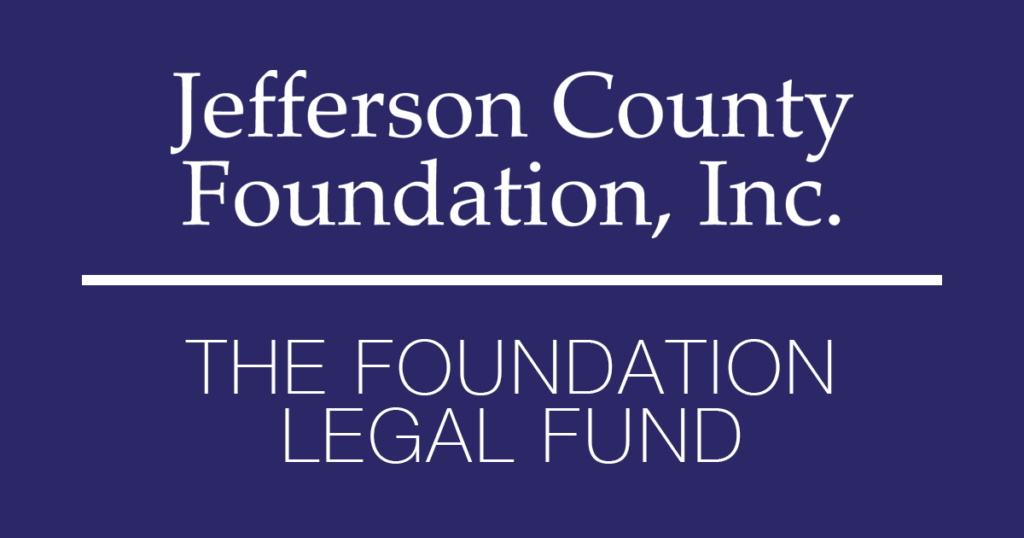
Thankfully, generous donors and hard-working volunteers are making our work possible, and we are making progress. If you agree that heavy industry threatens our region’s health, environment, and economy, please show your support by making a fully tax-deductible contribution to THE FOUNDATION LEGAL FUND. Help us keep up the fight!
Environmental Permit Cases
Rockwool claims one of the reasons it located in Jefferson County, WV was the “regulatory environment” and “permitting considerations.” Seems that it got what it came for, unfortunately. Our team has discovered, and is challenging, multiple examples of Rockwool’s being allowed to cut corners and ignore standards and rules that are meant to protect us from contamination of our ground and surface waters.
Background
In order for any entity to disturb more than an acre of ground, a valid stormwater permit is required to protect the ground and surface waters of our region.
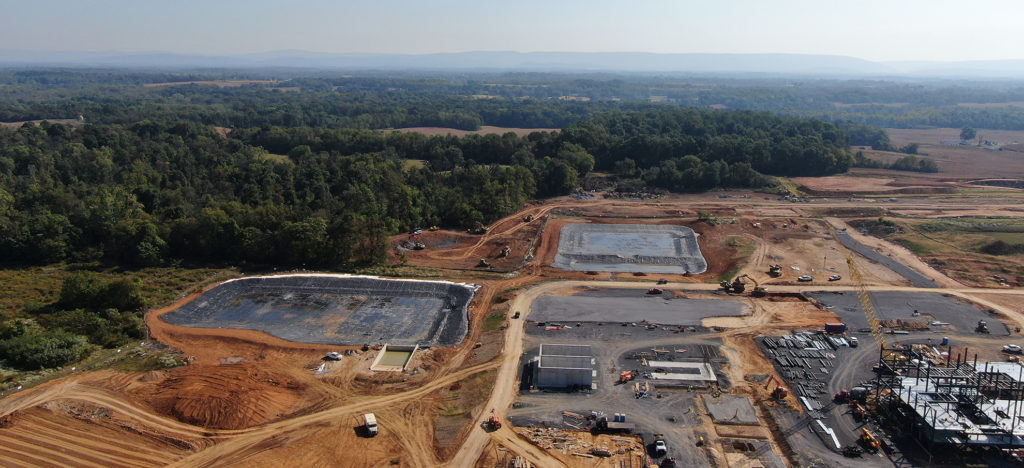
When Rockwool’s application for coverage under the construction stormwater General Permit was originally submitted, it was reviewed for only 11 days before approval. In its evaluation of the permit registration application, the Department of Environmental Protection (DEP) failed to note that:
Most egregiously the DEP allowed Rockwool to avoid public comment and notice by failing to require Rockwool to correct its reported “limit of disturbance” and its absurdly short (21 week) construction timeline.
In addition, the DEP did not require Rockwool to reapply for a stormwater permit as mandated, any of the several times their permit was modified. Then the DEP allowed Rockwool to operate without a valid permit for almost a year. These maneuvers further blocked the public’s ability to have input on Rockwool’s stormwater discharge management plan.
Rockwool finally reapplied for coverage last fall and repeated all of the errors noted above. Despite ample public opposition and scrutiny most of the public comments were only addressed in a cursory way and the permit was approved by the DEP. Jefferson County Foundation is appealing this permit (see below).
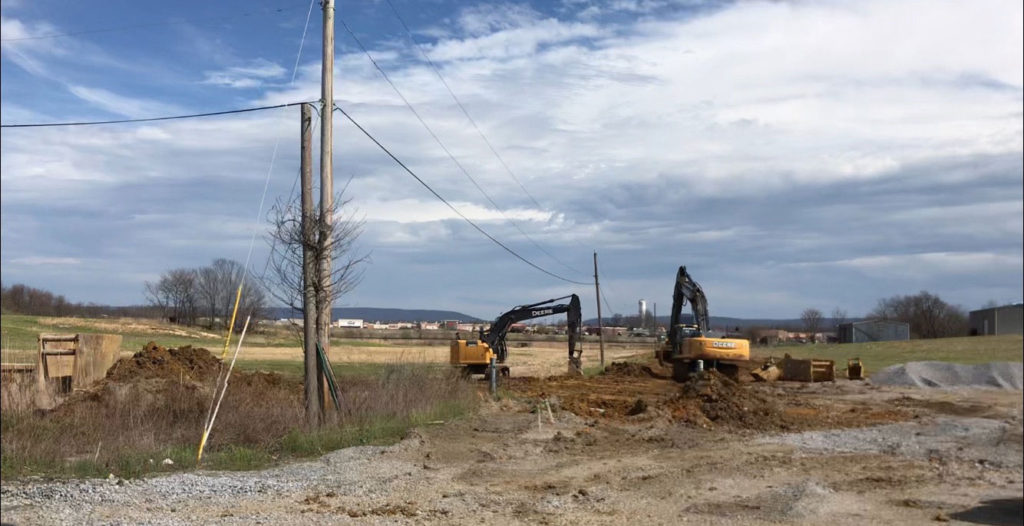
There is another stormwater permit-related set of issues. In 2019 when the DEP attempted to issue a new NPDES construction stormwater General Permit, that would have imposed more stringent requirements on both Rockwool’s construction project as well as the construction of the Rt. 9 “Super Sewer” to Rockwool project by Charles Town, David Yaussey (a prominent industry-side lawyer who represents Rockwool and multiple companies and associations in the state) filed an appeal to loosen or eliminate these requirements. The EPA, which must approve the changes, said “no.” What did the DEP do then? It disregarded the EPA, and issued an Order that allowed Charles Town to ignore the 2019 permit requirements. The DEP did the same thing for 697 other entities. Now Charles Town is building the Rt. 9 Sewer without a karst mitigation plan as required by the 2019 NPDES permit.
The Foundation’s Legal Challenges to These Environmental Permits
Jefferson County Foundation, and several citizens, have now sued the DEP in both cases – and the WV Environmental Quality Board (which hears initial appeals of DEP actions) has allowed all the players into the lawsuits: Charles Town and CTUB, represented by Steptoe & Johnson; Rockwool represented by Spillman, Thomas and Battle, the lawyers who routinely threaten to sue anybody who threatens Rockwool; and Lee Snyder, represented by Jackson Kelly. This is some heavy legal firepower lined up against our efforts to hold DEP and Rockwool accountable for compliance with the law and the protection of our waters.
But we are making progress and are fully engaged. Last week we filed over 2,000 pages of documents and answered over 60 legal discovery questions filed by the other side seeking such ridiculous and harassing information as the Foundation Board members’ septic tank maintenance records! And, the Foundation just filed our own discovery requests, seeking information about how the DEP could allow these projects to proceed without valid permits. We have asked the EQB to allow us to take a dozen depositions of employees of Rockwool, Snyder, CTUB, and the DEP. We have hired an expert in karst hydrogeology and our technical team members are analyzing the 1,000 pages of certified DEP record in both cases. We are represented by Chris Stroech of Arnold & Baily with help from the Foundation’s team of permitting experts, pro-bono lawyers, and other volunteers,
Both permitting cases are set for hearing in October and November, with deadlines and legal filings due every few weeks before then.
Environmental permits are required for a reason – and the DEP’s willingness to be bullied by the big law firms into sacrificing our water quality in favor of corporate desires for leniency, needs to be exposed and stopped.
Want more information? See our filings here.
Rockwool and Its Taxpayer-Subsidized “Free Money”
In 2019, without addressing the constitutionality of state tax incentives for Rockwool, Circuit Court Judge David Hammer ruled the original Payment In Lieu Of Taxes (PILOT) agreement that Rockwool had entered into with the Jefferson County Development Authority and other regional and local entities was invalid. Not to be deterred, Rockwool sought and obtained a tax-advantaged arrangement, providing for the issuance of up to $150 million in state-backed bonds, through the Charleston-based state agency, the WV Economic Development Authority, again without notice to the public.
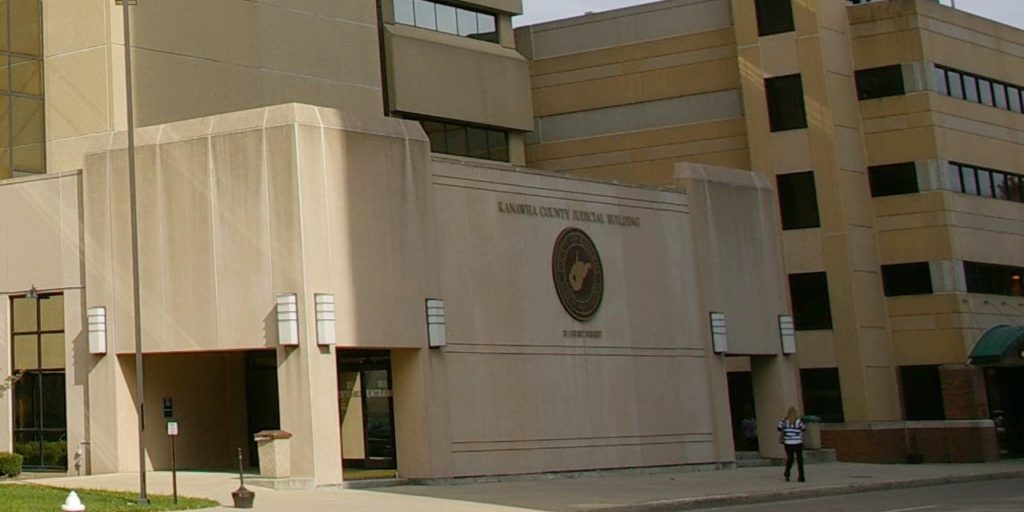
On April 23, 2020, the Jefferson County Foundation filed suit in Kanawha County Circuit Court challenging the constitutionality of the agreement between Rockwool and the WVEDA.
Notably, this agreement relieves Rockwool of state and local tax obligations for its property and equipment for 10 years.
Rockwool and its allies have filed two motions in response to the Foundation’s challenge: a motion to dismiss and a motion to move the case to a specialized “business court” where presumably it believes it will receive a more favorable hearing. Jefferson County Foundation has filed responses to both motions and are awaiting the court’s rulings.
Rockwool is represented by the law firm of Spilman Thomas & Battle. The Foundation is represented by Chris Stroech of Arnold & Bailey, Robert Bastrass III of DiPiero Simmons McGinley & Bastrass, and noted constitutional law professor Robert Bastrass, Jr.
The outcome of this case will have statewide implications and we are committed to seeing it through. The West Virginia Constitution promises that everyone will be taxed fairly and equitably. The scheme under which Rockwool gets 10 years’ worth of no property taxes is neither fair nor equitable, and it is not constitutional!
For more information on the Foundation’s challenge to the constitutionality of Rockwool’s tax break, see the filing here.
Support Our Efforts
If you agree that heavy industry threatens our region’s health, environment, and economy, please show your support by making a fully tax-deductible contribution to THE FOUNDATION LEGAL FUND. Help us keep up the fight!
Ranson Revenue from Rockwool?
Rebutting the recent article in the Spirit of Jefferson on July 1, 2020
The Spirit of Jefferson published another Rockwool propaganda piece on July 1, 2020, with no apparent regard for the facts and no effort made to cite real sources. Here is our fact-based rebuttal.
120 vs. 150 Jobs
In May of 2019, Rockwool finalized a deal with the West Virginia Economic Development Authority (WVEDA). This deal was a bond lease agreement in which the WVEDA will take ownership of Rockwool’s land and property for 10 years, which means Rockwool will not need to pay property tax during that time. The WVEDA also promised Rockwool up to $150 million in loans fulfilled with state-backed bonds. When it came time to sign the agreement on the dotted line, Rockwool was willing to commit only to “120 full-time equivalent jobs.” And in another WVEDA deal, this time in November 2019 to obtain state help to pay for its water lines, Rockwool again committed only to “120 full-time equivalent jobs.” That is one-fifth less than the 150 jobs the July 1 article claims.
Good paying jobs? Depends on your math.
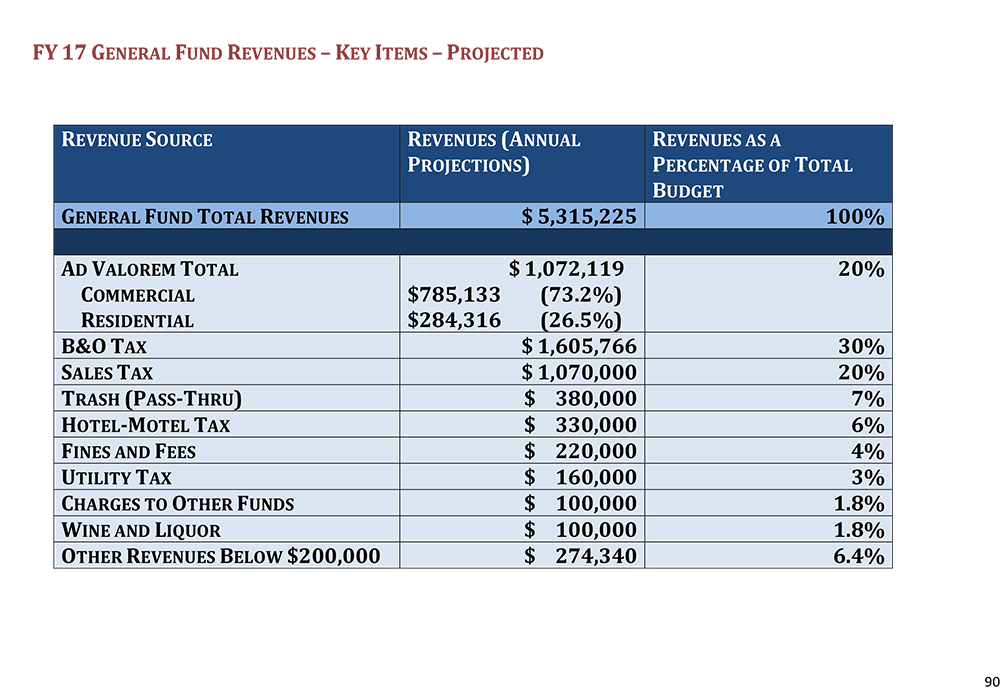
The article also repeated a claim of Espinosa, who apparently said that Rockwool would “generate” between $500,000 and $750,000 in taxes to Ranson a year. It would be very interesting to know what taxes these would be. According to Ranson’s 2017-2018 budget, the Revenue for the General Fund has three major sources: the Ad Valorem or property tax, B&O tax, and the 1% sales tax (Figure 1). With the execution of the WVEDA bond lease agreement as discussed above, Rockwool will have no property tax obligation and therefore, Ranson will collect no Ad Valorem Tax from Rockwool. The 1% sales tax is collected on retail sales and since Rockwool will have no appreciable retail sales in Ranson it therefore will not generate revenue for Ranson through the retail sales tax. B&O tax is also assessed on sales. The plant in Ranson is a manufacturing operation and Rockwool’s sales will likely be made from their headquarters in New Jersey. Therefore, Ranson is unlikely to collect any B&O tax from Rockwool either. The remainder of the taxes that round out the revenue for the Ranson General Fund are Hotel-Motel Tax, Fines and Fees, Charges to Other Funds, Garbage Service, Utility Tax, and Wine and Liquor. It is not plausible that Rockwool will be contributing significantly to any of these revenue streams. Where will this half- to three-quarters of a million dollars in tax revenue from Rockwool come from?
Paul Espinosa, public affairs manager for Rockwool Ranson and current member of the West Virginia House of Delegates (representing District 66), is cited as claiming that Rockwool’s employees will make on average $42,700 a year. This is a notable reduction from what was promised. A 2017 Deloitte economic impact study we obtained via FOIA, which was used to convince local leaders in the JCDA and elsewhere to support Rockwool, claimed the average yearly salary would be $46,611. Espinosa’s claim thus represents a surprising $3,911 per year reduction, or a more than 9% lower average pay from what was promised. Worse yet, according to the Deloitte economic impact study, paid for by Rockwool, the majority of workers (117 of them) will make an average of $31,000 a year – nowhere close to the $46,611 a year that was used to woo our public representatives.
$750,000 vs. nearly nothing
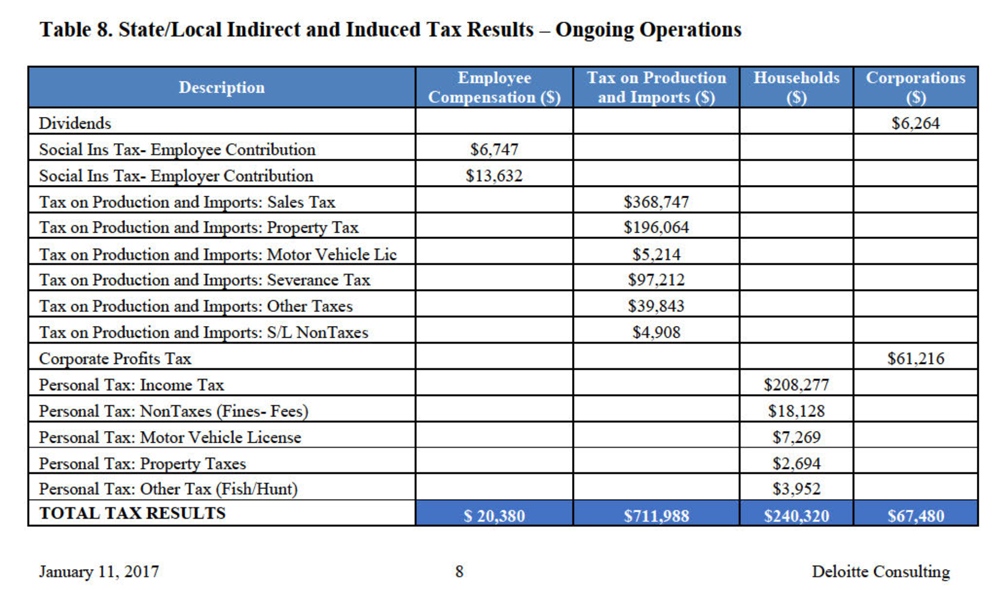
Figure 2. Source, Deloitte Economic Impact Study: Project Shuttle
It is likely that by “generate” Espinosa was slyly referring to “Indirect and Induced taxes” not taxes Rockwool will actually pay. This calculated estimated, explained in the Deloitte study, considers taxes generated by “business-to-business and household expenditure activities arising from the direct impact of Rockwool’s operations”. The issue is as explained above these business-to-business transactions will not occur in Ranson to any significant extent, because Rockwool’s suppliers are outside of Ranson. Similarly, the employees of Rockwool’s suppliers likely live nearer to those businesses and pay taxes there. Further may of the taxes taken into consideration in this calculation are state and federal not municipal taxes as can be seen in table 8.
The article also published Rockwool’s claim that for the first 10 years Rockwool will pay $40,000 in property and “other taxes.” Is Espinosa referring here to a payment in lieu of taxes? If so, we note that no payment in lieu of taxes is called for in the May 2019 WVEDA deal (which simply absolves Rockwool of their property tax burden altogether for a decade) and no other agreement providing for payments of this type can be found. And the article fails to say that only a minor portion (17%, according to the 2019 levy rate sheet) of this property tax money would go to Ranson no matter how much is paid.
Unexplained projections?
Espinosa further touts a $21.8 million yearly increase in economic activity in the county and claims that $5 million of that will be in Ranson. Frankly any rational consideration of this representation indicates it is impossible. What goods will Rockwool purchase in Ranson? There are no quarries in Ranson, no coal mines, no fracking pads, no formaldehyde concentrate dealers, no liquid oxygen suppliers – so what is Rockwool buying in Ranson to produce this $5 million impact? It is not plausible that this will all come from employee spending in Ranson. Even if every employee spent every last dollar they made after taxes and Rockwool indeed paid out $6.4 million in payroll it would not amount to $5 million in impact. This is just another in the long line of misleading and easily disproven claims to be made by Rockwool in its efforts to bring heavy industry to Jefferson County.

